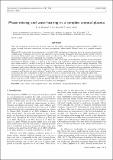Phase mixing and wave heating in a complex coronal plasma
View/
Date
04/2020Grant ID
647214
ST/S000402/1
RSWF\FT\180005
Keywords
Metadata
Show full item recordAbstract
Aims. We investigate the formation of small scales and the related dissipation of magnetohydronamic (MHD) wave energy through non-linear interactions of counter-propagating, phase-mixed Alfvénic waves in a complex magnetic field. Methods. We conducted fully three-dimensional, non-ideal MHD simulations of transverse waves in complex magnetic field configurations. Continuous wave drivers were imposed on the foot points of magnetic field lines and the system was evolved for several Alfvén travel times. Phase-mixed waves were allowed to reflect off the upper boundary and the interactions between the resultant counter-streaming wave packets were analysed. Results. The complex nature of the background magnetic field encourages the development of phase mixing throughout the numerical domain, leading to a growth in alternating currents and vorticities. Counter-propagating phase-mixed MHD wave modes induce a cascade of energy to small scales and result in more efficient wave energy dissipation. This effect is enhanced in simulations with more complex background fields. High-frequency drivers excite localised field line resonances and produce efficient wave heating. However, this relies on the formation of large amplitude oscillations on resonant field lines. Drivers with smaller frequencies than the fundamental frequencies of field lines are not able to excite resonances and thus do not inject sufficient Poynting flux to power coronal heating. Even in the case of high-frequency oscillations, the rate of dissipation is likely too slow to balance coronal energy losses, even within the quiet Sun. Conclusions. For the case of the generalised phase-mixing presented here, complex background field structures enhance the rate of wave energy dissipation. However, it remains difficult for realistic wave drivers to inject sufficient Poynting flux to heat the corona. Indeed, significant heating only occurs in cases which exhibit oscillation amplitudes that are much larger than those currently observed in the solar atmosphere.
Citation
Howson , T A , De Moortel , I & Reid , J 2020 , ' Phase mixing and wave heating in a complex coronal plasma ' , Astronomy & Astrophysics , vol. 636 , A40 . https://doi.org/10.1051/0004-6361/201937332
Publication
Astronomy & Astrophysics
Status
Peer reviewed
ISSN
0004-6361Type
Journal article
Description
Funding: UK Science and Technology Facilities Council (consolidated grants ST/N000609/1 and ST/S000402/1); European Union Horizon 2020 research and innovation programme (grant agreement No. 647214); Research Council of Norway through its Centres of Excellence scheme, project number 262622 (IDM); Carnegie Trust for the Universities of Scotland (JR).Collections
Items in the St Andrews Research Repository are protected by copyright, with all rights reserved, unless otherwise indicated.

